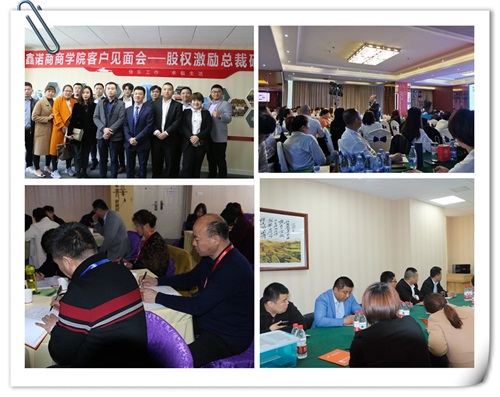

股權激勵方案中的“六定”是什么,?
發(fā)布時間:2023-12-12 來源:http://zyvd.cn/
(一)定人——確定激勵對象
(1) Fixed person - Determine incentive targets
定人,即在股權激勵方案設計中確定將哪些人作為激勵對象,,以此確定激勵對象的標準,。要確定合適的激勵對象,需要遵循以下原則:
Fixed person, that is, in the design of equity incentive plans, determine which individuals will be selected as incentive targets, in order to determine the standards for incentive targets. To determine suitable incentive targets, the following principles need to be followed:
其一,,一致性原則,,即對激勵對象采用統(tǒng)一的衡量標準。只有衡量標準相同的前提下,,才能確定激勵哪些員工是對企業(yè)更有益處的,。
One is the principle of consistency, which means adopting a unified measurement standard for the incentive target. Only with the same measurement standards can we determine which employees are more beneficial for the company to motivate.
其二,重要性原則,,激勵對象的選擇主要基于重要性原則,,需充分考慮激勵對象價值,確定符合條件的激勵對象,。
The second principle is the importance principle, and the selection of incentive targets is mainly based on the importance principle. It is necessary to fully consider the value of incentive targets and determine eligible incentive targets.
在一致性原則和重要性原則的指導下,,在確定激勵方案時應綜合考慮以下因素:
Guided by the principles of consistency and importance, the following factors should be comprehensively considered when determining incentive plans:
1.職級特征:經(jīng)營班子、核心技術骨干等,;
1. Job level characteristics: management team, core technical backbone, etc;
2.司齡特征:公司服務年限及本職工作年限等,;
2. Age characteristics: years of service in the company and years of work in the position;
3.歷史因素:激勵對象為公司貢獻的歷史業(yè)績等;
3. Historical factors: historical performance contributed by the incentive target to the company, etc;
4.其他特征:學歷因素,、可替代性因素等,。
4. Other characteristics: educational background, substitutability, etc.
在具體的操作中,,要綜合考慮以上因素,以公司組織架構和管理體系為基礎,,匡定理想持股人選,。
In specific operations, the above factors should be comprehensively considered, and the ideal shareholding candidate should be selected based on the company's organizational structure and management system.
(二)定量——確定激勵數(shù)量
(2) Quantitative - determining the number of incentives
定量,即在股權激勵方案設計中確定用于激勵的股份總量及個量,。要確定激勵的總量,,必須得做三方面考量:
Quantification refers to determining the total amount and quantity of shares used for incentives in the design of equity incentive plans. To determine the total amount of incentives, three aspects must be considered:
其一,得考慮企業(yè)大股東控制權,、業(yè)績目標,、企業(yè)規(guī)模、波動風險的預防,,這4個直接影響激勵總量確定的關鍵因素,;
Firstly, it is necessary to consider the control rights of major shareholders, performance goals, enterprise size, and prevention of volatility risks, which are four key factors that directly affect the determination of the total incentive amount;
其二,要對股權結構做分析,,比如對股權集中程度,、原始股東股權激勵、股權投資及控制權等做分析,,以確定股權激勵總額上線,;
Secondly, it is necessary to analyze the equity structure, such as the degree of equity concentration, original shareholder equity incentives, equity investment, and control rights, in order to determine the total amount of equity incentives to go online;
其三,考慮動態(tài)分配股權模式,,即根據(jù)公司發(fā)展階段,、人才需求、行業(yè)變化等情況逐年分次釋放,,一方面避免一次性分配造成的利益固化,,另一方面避免過度激勵及過度稀釋股權。
Thirdly, consider the dynamic allocation of equity model, which is to release the shares year by year based on the company's development stage, talent demand, industry changes, and other factors. On the one hand, it avoids the solidification of benefits caused by one-time distribution, and on the other hand, it avoids excessive incentives and dilution of equity.
個量的確定由企業(yè)根據(jù)自身現(xiàn)狀和激勵對象人數(shù)做具體的配比,,需要標明個量授予采取的動態(tài)方式,,規(guī)劃明確授予時間及節(jié)奏,在持續(xù)授予激勵的同時,,做好風險控制,。
The determination of individual quantity is determined by the enterprise based on its own current situation and the number of incentive recipients. It is necessary to indicate the dynamic method adopted for individual quantity awarding, plan and clarify the awarding time and rhythm, and ensure risk control while continuously awarding incentives.
(三)定價——確定授予價格
(3) Pricing - Determine Grant Price
定價,即在股權激勵方案設計中確定授予激勵對象的每股價格,。定價是關于利益的心理博弈,,得確定企業(yè)價值,再次確定每股定價,,后要標明購買方式,。除此而外,要使得定價結果更科學,在整個定價過程中需要注意以下三個原則:
Pricing refers to determining the per share price to be awarded to incentive recipients in the design of equity incentive plans. Pricing is a psychological game about benefits, which involves determining the value of the enterprise, re determining the price per share, and then indicating the purchasing method. In addition, to make the pricing results more scientific, the following three principles need to be noted throughout the entire pricing process:
1.明確股價的關鍵影響因素,,即每股價格=企業(yè)估值/總成本,;
1. Clarify the key influencing factors of stock price, that is, price per share=company valuation/total cost;
2.確保“同股同價”,,即同一批授予/發(fā)行價格應該保持一致,;
2. Ensure that "the same shares and the same price", that is, the same batch of grant/issue prices should be consistent;
3.明確大前提,即在公司不虧損情況下,,后面的價格比前面的價格高,。

3. Clarify the main premise, that is, under the condition that the company does not incur losses, the prices in the later stages are higher than those in the earlier stages.
(四)定條件——確定考核條件
(4) Setting conditions - determining assessment conditions
定條件,即在股權激勵方案設計中確定激勵對象的考核條件,。從企業(yè)層面考慮,,如果企業(yè)整體業(yè)績條件未達標時,則所有激勵對象不得行權或解鎖獲益,;如果公司業(yè)績達標時,,則所有激勵對象滿足了行權或解鎖的條件之一者,,再具體根據(jù)個人業(yè)績條件確定是否滿足考核要求,。于激勵對象個人而言,具體授予比例與個人業(yè)績考核結果掛鉤,。方案設計階段確切的標明條件,,將會避免很多在方案執(zhí)行過程中可能遇到的阻力與困惑。
Setting conditions, that is, determining the assessment conditions for incentive targets in the design of equity incentive plans. From the perspective of the enterprise, if the overall performance conditions of the enterprise are not met, all incentive objects shall not exercise or unlock benefits; If the company's performance meets the standards, all incentive recipients who meet one of the conditions for exercising or unlocking will be determined based on their individual performance conditions to determine whether they meet the assessment requirements. For individual incentive recipients, the specific award ratio is linked to the individual's performance evaluation results. The precise identification of conditions during the scheme design phase will avoid many obstacles and confusion that may be encountered during the scheme execution process.
(五)定時間——確定授予的具體時間
(5) Set time - determine the specific time of award
定時間,,即在股權激勵方案設計中確定個量動態(tài)授予的具體時間及節(jié)奏,。在授予過程中可按5+3+2或者4+3+3等節(jié)奏采取逐步授予(行權條件)的形式,同時,,也可根據(jù)激勵對象具體的績效計算其每年應獲得的股權數(shù)量多少,,以按照授予節(jié)奏規(guī)劃授予。
Fixed time refers to determining the specific time and rhythm of individual dynamic grants in the design of equity incentive plans. During the grant process, a gradual grant (exercise condition) can be adopted according to the rhythm of 5+3+2 or 4+3+3. At the same time, the amount of equity that the incentive object should receive each year can be calculated based on their specific performance, in order to plan the grant according to the grant rhythm.
(六)定來源——明確股份來源,、資金來源
(6) Fixed source - Clarify the source of shares and funds
定來源,,即確定用于股權激勵的股份的來源、資金的來源,。股權激勵即以股權授予激勵對象以起到獎勵歷史貢獻者,、留住核心骨干、吸引優(yōu)秀人才的作用,,形成企業(yè)具有競爭力的人才激勵機制,。這顯然是企業(yè)實行股權激勵的前置條件。企業(yè)股權激勵實施是否可行,,方案設計中能否明確股權來源,,以及來源是否具有可操作性都是很重要的考量因素。
Determine the source, that is, determine the source of shares and funds used for equity incentives. Equity incentive refers to the granting of equity to incentive objects to reward historical contributors, retain core talents, and attract outstanding talents, forming a competitive talent incentive mechanism for enterprises. This is clearly a prerequisite for enterprises to implement equity incentives. The feasibility of implementing equity incentives in enterprises, whether the source of equity can be clearly defined in the design of the plan, and whether the source is operable are important factors to consider.
本站聲明
本網(wǎng)站為非營利性網(wǎng)站,,旨在宣揚股權知識,交流職業(yè)學習心得,。網(wǎng)站內(nèi)部分文章來自其它網(wǎng)站,,只做交流學習之用。相應的權力均屬于原權 力人,,如權利人認為不妥,,請來電來函說明,本網(wǎng)站隨既停止或使用,,謝謝合作,! 13698613138
13698613138
微信公眾號

掃碼獲知更多知識

抖音二維碼
山東股章企業(yè)管理顧問有限公司 備案號:魯ICP備19050574號-2 網(wǎng)站建設·推廣運營 網(wǎng)站地圖 XML TXT

截屏,微信識別二維碼